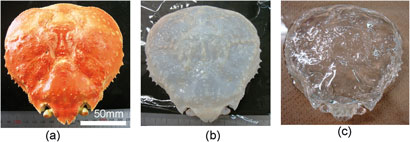Japanese Scientists Turn a Crab Shell Completely Transparent
Sure, transparent mouse embryos are cool, but how about transparent crab shells? That’s what researchers at Japan’s Kyoto University have been working on and successfully accomplished. Why did they do this, you might ask. For science?! Well, yes, but also because the transparent chitin, the material the shell is mad out of, could have very useful applications in electronics. But be warned, transparency comes with casualties. These crabs clearly (get it?!) didn’t survive.
The first step in the transparency process was to soak the pour guys in hydrochloric acid, sodium hydroxide, and ethanol to remove all the matter that wasn’t chitin. You know, all the alive-y parts. In addition to leaving only the chitin shell, the chemical bath also bleached the shell, preparing it for the next and last step: A bath of acrylic resin monomer. After that, the shell was completely clear, but otherwise unaltered, still retaining its shape, down to the now creepily vacant eye-stalks.
As for applications in electronics, the transparent chitin has an extremely high light transmittance, meaning that it could be very useful in flat panel displays and the like. Currently, the material of choice is a glass-fiber epoxy composite, which works fine at lower temperatures, but suffers around a 65% decrease in light transmittance as it reaches temperatures around 100 degrees Celsius (that’s 212 Fahrenheit for those of you who haven’t been in school for a while). While this isn’t often a problem, it is if you’re dealing with solar panels. Chitin, in comparison, does not expand with heating and experiences no loss of transmittance, making it great for solar panels, in theory.
If this technology really takes off, there’s good news: chitin is not only present in crab shells specifically, but in the exoskeletons of pretty much all crustaceans, in addition to many insects and most arachnids. As a bonus, there will be plenty of otherwise garbage shells from the food industry that might soon have a technological use. Probably not enough to satisfy demand, but still some. Transparent animals sure are coming down the pipe fast these days. Here’s to hoping someone can figure out how to make an animal that is transparent and alive.
(via PhysOrg, Royal Society of Chemistry)
- Transparent mouse embryos made using urea
- Transparent dress can alter its transparency
- Transparent lithium-ion batteries
Have a tip we should know? tips@themarysue.com
